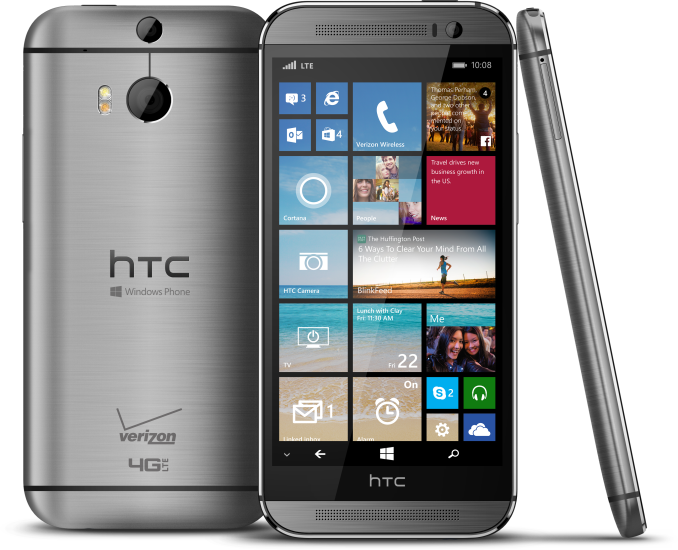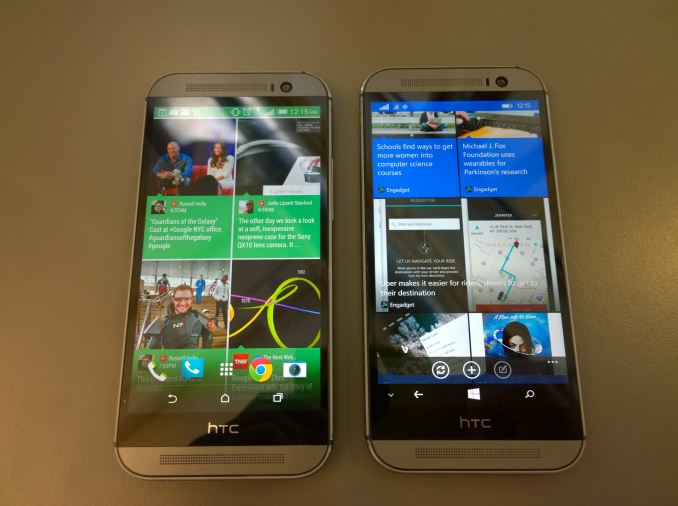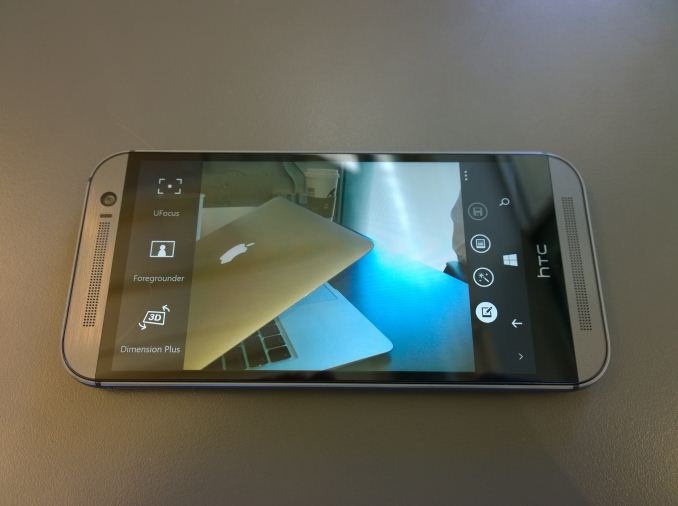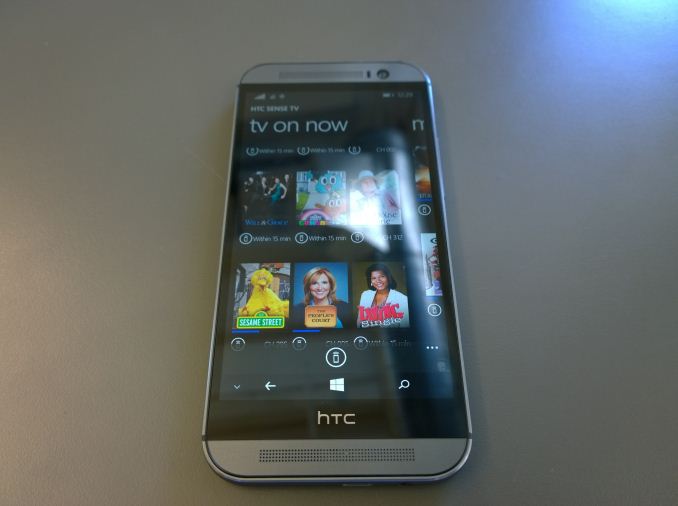HTC Announces the HTC One (M8) for Windows
by Brandon Chester on August 19, 2014 10:45 AM EST- Posted in
- Smartphones
- HTC
- Mobile
- Windows Phone 8.1
- One (M8)

It's been a while since we've seen a high-end device running Windows Phone 8 launch from a company other than Nokia. Despite Nokia's dominance, HTC has certainly not given up on the platform and today they're demonstrating that with the launch of a new flagship Windows Phone 8 device that you may already know very well. This new device is named the HTC One (M8) for Windows, and both its design and its hardware are essentially the same as the Android powered HTC One M8 that HTC launched earlier this year. We've laid out the specifications of the One (M8) for Windows below.
| HTC One (M8) for Windows | ||||||
| SoC |
Qualcomm Snapdragon 801 (MSM8974ABv3) 4 x Krait 400 at 2.26GHz Adreno 330 at 578 MHz |
|||||
| Memory and Storage | 2GB LPDDR3, 16/32GB NAND + microSDXC | |||||
| Display | 5” 1920x1080 Super LCD3 at 441 ppi | |||||
| Cellular Connectivity | 2G / 3G / 4G LTE (Qualcomm MDM9x25 UE Category 4 LTE) | |||||
| Dimensions | 146.36 x 70.6 x 9.35mm max, 160 grams | |||||
| Camera | 4.0 MP (2688 × 1520) Rear Facing with 2.0 µm pixels, 1/3" CMOS size, F/2.0, 28mm (35mm effective) and 2.0MP rear DOF camera, 5MP F/2.0 FFC | |||||
| Battery | 2600 mAh (9.88 Whr) | |||||
| Other Connectivity | 802.11a/b/g/n/ac + BT 4.0, USB2.0, GPS/GNSS, MHL, DLNA, NFC | |||||
| SIM Size | Nano-SIM | |||||
| Operating System | Windows Phone 8.1 | |||||
With regards to the hardware there's not a whole lot to be said. This really is the HTC One (M8) running Windows Phone 8 instead of Android. For an in depth look at the experience on Windows Phone 8.1 you can take a look at Anand's review of it from earlier this year. HTC has worked to also bring over some of the features they include with HTC Sense on the One (M8), which include BlinkFeed, Duo Cam, and Sense TV.
BlinkFeed makes its way over to Windows Phone 8 with the One (M8) for Windows. For those who arent familiar with it, BlinkFeed is a feature that comes on some of HTC's Android devices which aggregates Facebook and Twitter posts, news, sports information, and more into a vertically scrolling list on HTC's launcher. On Windows Phone 8 HTC doesn't have the luxury of being able to drastically alter the launcher and so BlinkFeed is included as an application which functions in the same manner as the launcher widget on Android.
Because the One (M8) for Windows shares the same hardware as the M8, HTC has brought over their post processing effects enabled by the secondary sensor in their Duo Cam camera system. In addition, we see that Video Highlights is present in the stock OS. Unfortunately, the camera app doesn't also inherit the manual controls from the M8 and so users wanting more control over the exposure of their photos will have to look to Nokia's Windows Phone devices or buy an application like ProShot which has such controls.
The One (M8) for Windows also brings along HTC Sense TV which acts as a TV guide and a universal remote that displays when your favorite shows are playing as well as recommendations for shows you may like based on what you already watch. HTC emphasized the difficulty of bringing this functionality to Windows Phone, as it required close cooperation with Microsoft to properly implement IR remote functionality.
For some users the most exciting prospect of the HTC One (M8) for Windows may come from the fact that it shares the same hardware as the One (M8). It's possible that the developer community will be able to load the firmware from the HTC One (M8) onto the device in a dual boot configuration with Windows Phone 8 so users can switch between the operating systems as they please.
Overall, this seems to be a smart move for HTC. Instead of assuming additional risk in the form of new hardware, the only resources needed are for software development. There's no need for a new production line, hardware certification is easier because the hardware should be unchanged from other variants, and cost across the board is driven down due to increased economies of scale.
The HTC One (M8) for Windows will go on sale on August 19th at 12:00PM Eastern Time through Verizon's online store, and will be available for $99 on a two year contract.



















60 Comments
View All Comments
Sushisamurai - Tuesday, August 19, 2014 - link
Yeah, I'd have to say the #1 thing I miss from these smart phones is a dedicated 2 stage camera button. It's not to activate the camera app that's important, it's the 2 stage button part that's useful.With 2 stage, u can lock in a specific focal distance (and exposure), and then pan to a different scene and capture crazy pictures. To do the exact same thing on a touch to focus, you have to touch the screen, and hope it doesn't lose focus when u move/pan to a different scene. That or try holding ur finger on the screen when panning (which never seems to work)
flutberf - Tuesday, August 19, 2014 - link
The best feature IMO is that if you hold it down it will wake the device directly into the camera. It's one of my favorite features on my Z1s.althaz - Tuesday, August 19, 2014 - link
You mean except be a genuine 2-stage camera button that's in the correct place for a right-handed person to use?Brett Howse - Tuesday, August 19, 2014 - link
Yes Microsoft needs to add a swipe to go to camera feature to WP much like they have on Windows 8.1. One of my biggest issues with the Lumia 630 trying to use it as a daily phone was that Windows Phone wasn't set up for this no camera button on the software side. Yes you can add it to the action center, and yes you can add it to the start screen, but being able to access the camera from the lock screen on devices without a camera button would be much better and faster.Hopefully it's going to come with Threshold I can't see why it wouldn't.
Brett Howse - Tuesday, August 19, 2014 - link
First Windows Phone with Snapdragon 801. This is what Windows Phone needed more than anything - to be on hardware parity with Android in a reasonable timeframe.inighthawki - Tuesday, August 19, 2014 - link
What is with this strange fascination of people to judge the quality of a phone by whether or not it has the highest end processor in it? Almost nobody needs that kind of high end chip in their phone. Such a spec is completely useless to 98% of the population.Brett Howse - Tuesday, August 19, 2014 - link
First off, it's not useless. If that was the case, the Lumia 630 would be all you ever needed but that's certainly not the case. The UI on Windows Phone has always been excellent even with low end hardware but everything is improved with a more powerful CPU.Web browsing is faster, opening apps is faster, navigating apps is faster, opening the camera is faster, getting focus is faster, taking pictures is faster.
Plus, with Windows Phone marketshare, they can't afford to always be way behind on features. It's a big win for Microsoft that HTC was able to use the EXACT same hardware and just put their OS on it - that wasn't always the case.
You can't expect to gain ground on the competition when you are always behind. My point regardless wasn't that this is instantly a better phone than any Nokia because of the SoC, but that Windows Phone has hardware parity with Android in a short time frame. It's a big win whether you discount it personally or not.
As someone who uses a Lumia 1020 every single day, I can say unequivocally that yes I need a faster SoC.
inighthawki - Tuesday, August 19, 2014 - link
No, you're misinterpreting me. I don't mean that faster hardware cannot b a great selling point. What I mean is there are people who place far too much weight on whether or not it's literally *THE* top of the line, even if the next best thing is, for all intents and purposes, a negligible performance difference. I've literally seen people say a phone was bad because it *only* had a snapdragon 800, and it was midrange trash compared to an 801 or 805. Yet the difference between them is pretty much unnoticeable to all but the absolute most hardcore users who run benchmarks and actually generate numbers to prove their point.There seems to be some sort of cult around phones where this is ay too important. I've seen people build gaming computers where "an i5 is perfectly fine" over the choice of an i7, but suddenly in the mobile space with phones, a Snapdragon 800 is completely unacceptable, despite the only difference is that your webpages take 1.2ms longer to load.
Brett Howse - Tuesday, August 19, 2014 - link
Ah ok I see what you mean. My point was it's exciting to see a Windows Phone that's on the current top hardware in the same quarter as Android :) Hopefully it continues going forward.inighthawki - Wednesday, August 20, 2014 - link
Yep. It will definitely be nice too see them competing on all fronts.